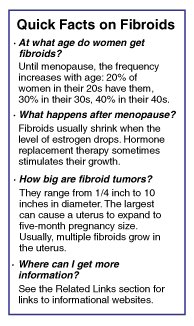Kinder, Gentler Treatment of Fibroids
A new technique for treating fibroid tumors is quick, uses local anesthesia, and has women back at work in a week.
Fibroids, noncancerous growths in the muscular wall of the uterus, are the most common tumors of the female genital tract. While small fibroids seldom cause problems, larger ones are often treated by removing the uterus, leading to more than 175,000 hysterectomies a year. When a recent University of California, Los Angeles, study of 497 hysterectomies found that 60 percent were a result of fibroids, researchers recommended exploring alternative treatments.
One very promising new option is uterine artery embolization, or UAE, which was first performed in France in the early 1990s. "UAE is a new application of an established technique; embolization of uterine arteries has been used for 20 years to stop life-threatening bleeding after childbirth," says Robin Boyd-Kranis, M.D., a radiologist and an assistant professor of interventional radiology at the University of Maryland. In UAE, a physician uses X-ray imaging to guide a catheter to arteries supplying blood to the uterus and injects tiny plastic particles (each about the size of a grain of sand). This process decreases blood flow to the uterine fibroids and shrinks them over a period of six weeks, Dr. Boyd-Kranis explains.
About 4,000 UAEs have been performed in the United States since 1995. After the one- to two-hour procedure, most patients are out of bed in six hours and back to normal activity in a week, Dr. Boyd-Kranis finds. For pain control, the surgeon admits her UAE patients overnight.

Traditional fibroid treatments also include myomectomy, a major surgery to remove the tumors themselves. Usually bringing more blood loss than a hysterectomy, this procedure involves incisions into both the tumors and the abdominal wall; it works best for women with only one or two fibroids. As Dr. Boyd-Kranis explains, however, "Women have been asking for less radical treatments than surgery for this problem; UAE is proving quite promising in abating fibroid symptoms. The procedure is safe and effective. Most women receiving it are in their 30s and 40s. Eighty-five to 90 percent require no further treatment."
Common fibroid symptoms include abnormal bleeding (such as unusually heavy menstrual periods), pelvic pressure or pain, frequent urination, and constipation. Fibroids can impede fertility or even cause miscarriage if a placenta implants over a tumor. Their growth is stimulated by the presence of estrogen and progesterone.
The new procedure is not for everyone. Women with a history of pelvic infection, for example, must make sure none is present before having UAE. In addition, research is underway on whether UAE has any effect on fertility. If you plan to have children, consider myomectomy first, Dr. Boyd-Kranis advises.
Only 10 to 20 percent of women with fibroids ever require treatment. Most tumors are discovered when a gynecologist notices a patient's enlarged uterus. Painless diagnostic tests to confirm fibroids include abdominal ultrasound (which shows uterine size, shape, and texture on a computer screen), magnetic resonance imaging (MRI), and computed tomography (CT) scans. Diagnostic hysteroscopy, a less comfortable procedure, is performed by a gynecologist who checks for growths and takes tissue samples.
Will your health insurance cover UAE? Dr. Boyd-Kranis makes sure her patients are pre-approved by their insurance companies. While some HMOs are resistant, she finds physicians can write successful appeals. Treatment is "usually covered -- but discuss it with your doctor before the procedure," the surgeon urges.
Related links:
Society of Cardiovascular & Interventional Radiology
Fibroid Background Information from Georgetown University Medical Center
The Fibroid Uterine Treatment Center
The Fibroid Embolization Center at the New York United Hospital Medical Center
Send feedback on this article.

